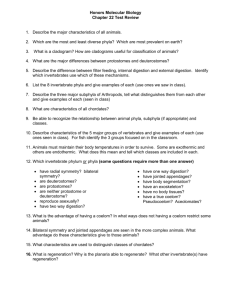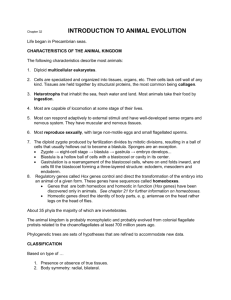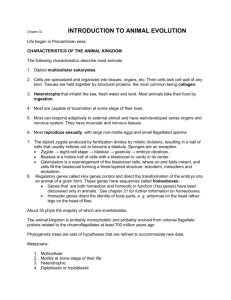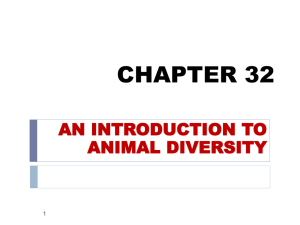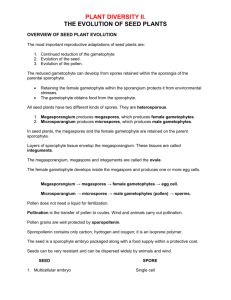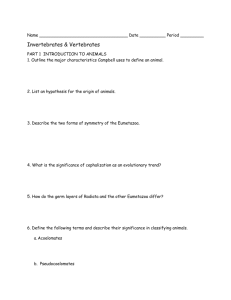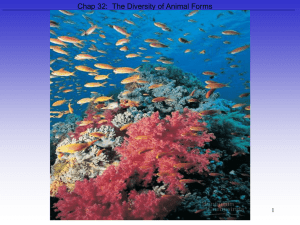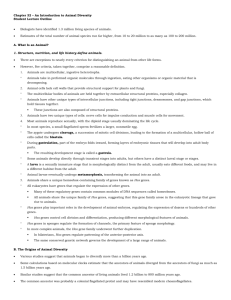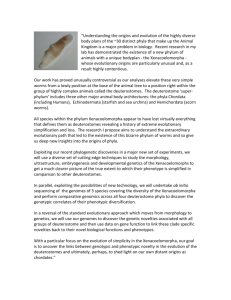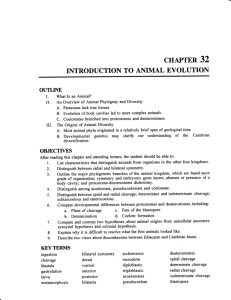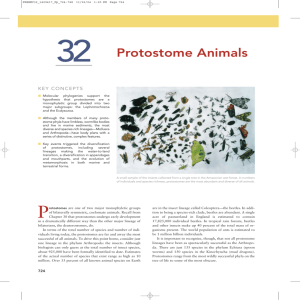Chapter 32 Introduction to Animal Diversity
advertisement
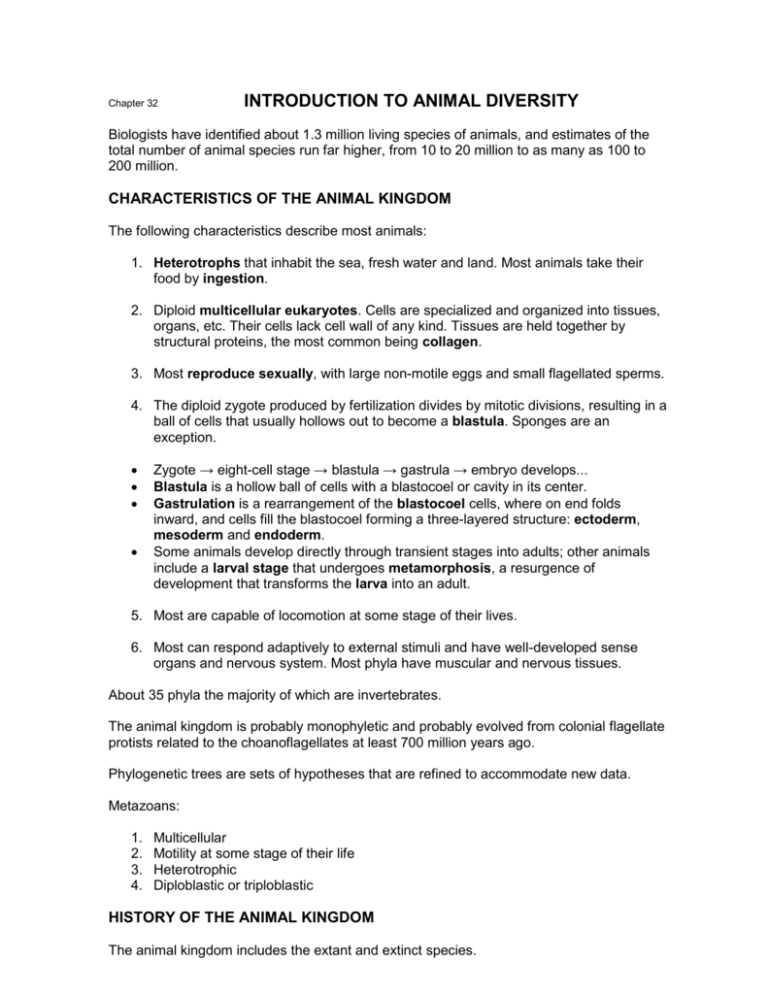
Chapter 32 INTRODUCTION TO ANIMAL DIVERSITY Biologists have identified about 1.3 million living species of animals, and estimates of the total number of animal species run far higher, from 10 to 20 million to as many as 100 to 200 million. CHARACTERISTICS OF THE ANIMAL KINGDOM The following characteristics describe most animals: 1. Heterotrophs that inhabit the sea, fresh water and land. Most animals take their food by ingestion. 2. Diploid multicellular eukaryotes. Cells are specialized and organized into tissues, organs, etc. Their cells lack cell wall of any kind. Tissues are held together by structural proteins, the most common being collagen. 3. Most reproduce sexually, with large non-motile eggs and small flagellated sperms. 4. The diploid zygote produced by fertilization divides by mitotic divisions, resulting in a ball of cells that usually hollows out to become a blastula. Sponges are an exception. Zygote → eight-cell stage → blastula → gastrula → embryo develops... Blastula is a hollow ball of cells with a blastocoel or cavity in its center. Gastrulation is a rearrangement of the blastocoel cells, where on end folds inward, and cells fill the blastocoel forming a three-layered structure: ectoderm, mesoderm and endoderm. Some animals develop directly through transient stages into adults; other animals include a larval stage that undergoes metamorphosis, a resurgence of development that transforms the larva into an adult. 5. Most are capable of locomotion at some stage of their lives. 6. Most can respond adaptively to external stimuli and have well-developed sense organs and nervous system. Most phyla have muscular and nervous tissues. About 35 phyla the majority of which are invertebrates. The animal kingdom is probably monophyletic and probably evolved from colonial flagellate protists related to the choanoflagellates at least 700 million years ago. Phylogenetic trees are sets of hypotheses that are refined to accommodate new data. Metazoans: 1. 2. 3. 4. Multicellular Motility at some stage of their life Heterotrophic Diploblastic or triploblastic HISTORY OF THE ANIMAL KINGDOM The animal kingdom includes the extant and extinct species. Some biologists estimate that up 99% of animal species are extinct. Some calculations based on molecular clocks suggest that the ancestors of animals diverged from the ancestors of plants about 1.5 – 1.8 billion years ago. Neoproterozoic Era (1 billion to 542 million years ago) This era is also known as the Precambrian. The earliest accepted fossil animals are about 575 million years ago. These fossils are known collectively as the Ediacaran fauna. First described from the Ediacara Hills of southern Australia, but have since been found all over the world. Several body plans have been observed: animals with both radial and bilateral symmetry, feather-like and worm or tube-like forms, etc. Most of the animals in the Ediacaran fauna appear to be cnidarians and possibly mollusks. Paleozoic Era (542 to 251 million years ago) At the beginning of the Cambrian, about 545 m.y.a. there was an explosive radiation of multicellular animals. This event is called the Cambrian explosion. Rapid evolutionary changes occurred in the late Proterozoic and ended in the Early Cambrian. A change from mostly simple organisms to complex organisms comparable to present day animals. This happened in 40 million years, 542 - 525 m.y.a. It was a period of great evolutionary innovation. Almost all metazoa phyla appeared at this time. Hypotheses about the causes of the Cambrian explosion These three hypotheses are not mutually exclusive. Ecological causes: Predators feed on the most abundantly prey species thus reducing their numbers and letting others use the resources. Cropping of a dominant species opens many niches, which become occupy by species previously excluded. Increase in prey species leads to an increase in predators. Geologic causes: Oxygen may have reached critical threshold at this time. Oxygen supports a more active metabolism, which is required by fast moving animals. Genetic causes: Ohno claims that early Cambrian animals possessed genes capable of forming oxygen cross-links in collagen, in ligaments and tendons; hemoglobin; and homeobox proteins that help orient body plans along a directional axis. The diversification of animals is associated with the evolution of Hox regulatory genes, which lead to variation in morphology. The end of the Cambrian radiation locked the animal phyla locked into developmental patterns that constrained evolution enough that no additional phyla evolved after that period. http://www.ucmp.berkeley.edu/vendian/ediacara.html http://palaeo.gly.bris.ac.uk/Palaeofiles/Cambrian/controversies/timetable/timetable.html http://www.teaching-biomed.man.ac.uk/bs1999/bs146/biodiversity/orirelho.htm The Cambrian period was followed by the Ordovician, Silurian and Devonian periods, when animal diversity continues to increase, although punctuated by mass extinctions. Mass extinctions: http://hannover.park.org/Canada/Museum/extinction/extincmenu.html The earliest fossils of land plants are from the Silurian, about 420 million years ago. There are indications, however, that land plants appeared as early as 475 million years ago, in the Ordovician. Fungi accompanied plants in their colonization of the terrestrial environment. Arthropods (millipedes and centipedes) are the first animals to invade the land about 450 million years ago. Scorpions and spiders followed. All of this in the Ordovician. Vertebrates made the transition to lands about 360 million years ago, in the Devonian. Amphibians evolved into reptiles during the Carboniferous, about 300 million years ago. The great Permian extinction occurred about 250 million years ago and marks the end of the Paleozoic. Mesozoic Era (251 to 65.5 million years ago) Early reptiles evolved into dinosaurs. Gymnosperms are the dominant vegetation on land. Birds appeared about 150 million years ago in the late Jurassic. There is a great debate about the origins of birds and the time in which they first appeared. The earliest mammal is from about 135 million years ago, in the early Cretaceous. Angiosperms evolve flowers about 130 million years ago. Again, several opinions about the origin of the angiosperms. The great Cretaceous extinction (65 million years ago) marks the end of the Mesozoic and the elimination of the dinosaurs. Cenozoic Era (65.5 million years ago to the present) The early Cenozoic marks the rise and diversification of mammals. The angiosperms become the dominant vegetation on land. The coevolution of angiosperms and animals increases selection and diversification in both groups. CLASSIFICATION Based on type of … 1. 2. 3. 4. Body symmetry: radial, bilateral. Presence or absence of true tissues. Body cavity: acoelomate, pseudocoelomates, and coelomates. Developmental pattern: protostomes, deuterostomes. 1. Body symmetry (radial, bilateral) and germ layers. The eumetazoans are divided into two major branches based in part on body symmetry. a. The phyla Cnidaria and Ctenophora have radial symmetry and collectively called radiata. These animals have a top and bottom ends or an oral and aboral side, but they don't have a head or tail end or a right and left side. b. All other eumetazoans posses bilateral symmetry and are collectively called bilateria. Types of sectioning a specimen: Sagittal section divides the body into right and left parts. Cross or transverse section divides the body into anterior and posterior parts. Frontal section divides the body into dorsal and ventral parts. Bilaterians show a trend towards cephalization, the concentration of sensory organs at one end, the anterior end or head. The head end is an adaptation to movement. 2. Presence or absence of true tissues. Sponges have a unique simplicity that separates them from all other animals. They lack true tissues and they are called parazoans, meaning "beside the animals." All other animal phyla have true tissues and are called eumetazoans. Another difference in body plan separates the radiata from the bilateria. a. During gastrulation, bilaterians develop three germ layers and are called triploblastic: Ectoderm covers the surface of the embryo and gives rise to the outer covering of the animal and, in some phyla, to the central nervous system. Endoderm, the innermost germ layer, lines the developing digestive tube or archenteron, and gives rise to the lining of the digestive tract and organs like the liver and lungs. Mesoderm is located between the previous two layers and forms the muscles and most other organs. b. The radiata have two germ layers. The central portion is not homologous with that of the bilaterians. The radiata are said to be diploblastic, having two germ layers. 3. Body cavity: acoelomate, pseudocoelomates, coelomates. Coelom or body cavity is fluid-filled space located between the outer body wall and the digestive tube. Triploblastic animals may be... Acoelomate: lack coelom or body cavity, e.g. flatworms. Pseudocoelomate: coelom is partially lined with mesoderm, e.g. roundworms, rotifers. Coelomate: coelom is completely lined with mesoderm, e. g. mammals. The pseudocoelomate animals include the Rotifera, Gastrotrichia, Kinorhyncha, Loricifera, Priapulida, Nematoda, Nematomorpha, Acanthocephala, and Entoprocta. 4. Developmental pattern: protostomes, deuterostomes. a. Fate of the blastopore: Animals can be classified as protostomes if the blastopore develops into the mouth (mollusks, annelids, etc.) and Deuterostomes if it develops into the anus (echinoderms, chordates). b. Deuterostomes and protostomes have different pattern of cleavage: Radial cleavage is characteristic of deuterostomes; Spiral cleavage is followed by protostomes. c. Two different patterns of coelom formation: Schizocoely method of coelom formation is characteristic of protostomes. Deuterostomes follow the enterocoely pattern of coelom formation. d. Time of fixing the fate of embryonic cells Protostomes also have a determinate cleavage in which the fate of the embryonic cells is fixed very early in development. Deuterostomes have an indeterminate cleavage in which each cell keeps longer the capacity to develop into a full organism. Protostomes Blastopore becomes the mouth Spiral cleavage Determinate fate of early cells Schizocoelous coelom formation Deuterostomes Blastopore becomes the anus. Radial cleavage Indeterminate fate of early cells. Enterocoelous coelom formation HYPOTHESES ABOUT THE ANIMAL PHYLOGENETIC TREE The two leading hypotheses about the phylogenetic tree of animals are based on morphology and on molecular data. Points of agreement 1. All animals share a common ancestor. In other words, the animal kingdom is monophyletic. 2. Sponges (phylum Porifera) are basal animals. They diverged early from the rest of the animal kingdom. Tissues evolved only after sponges diverged from other animals – parazoans: beside the animals. 3. The Eumetazoa is a clade of animals with true tissues. The common ancestor of all animals except the sponges evolved true tissues. The basal eumetazoans are the phyla Cnidaria and Ctenophora, which are diploblastic and have radial symmetry (the radiata). 4. The Bilateria is a monophyletic group that includes all animals with bilateral symmetry. 5. Vertebrates and some other clades belong to the Deuterostomia. The name Deuterostomia refers to an animal developmental grade and also to a clade that includes the vertebrates. Disagreement over the Bilaterians. Molecular systematics is moving around several branches of the phylogenetic tree created using morphological data. Molecular systematists base their decision on the nucleotide sequences in the small subunit ribosomal RNA, and the sequence of the Hox genes. It is based on very few genes. Morphological data produces a tree that divides the Bilateria clade into two groups: protostomes and deuterostomes. Based on molecular data, some zoologists split the protostomes into two groups, the Lophotrochozoa and the Ecdysozoa. The name Lophotrochozoa is derived from two different structures observed in the animals belonging to this clade: The lophophore, a crown of ciliated tentacles used in feeding. The trochophore larval stage observed in groups without the lophophore. Phylogenetic studies based on large databases will likely provide further insights into animal evolutionary history. The acoelomate flatworms were traditionally classified with the Platyhelminthes. However, recent research indicates that the acoel flatworms are basal bilaterians, not members of the phylum Platyhelminthes. Acoelan’s basal position suggests that the bilaterians may have descended from a common ancestor that resembled living acoel flatworms – from an ancestor that had a simple nervous system, a saclike gut, and no excretory system.
